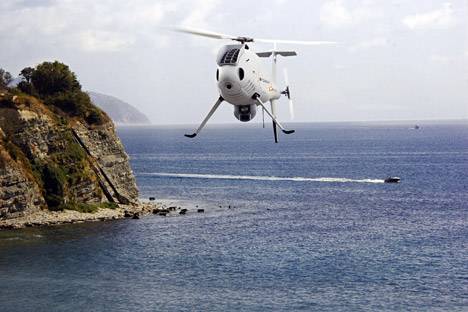
Experts believe that possible military conflicts in the not-too-distant future will be determined to a great extent by engaging with the enemy’s surface forces and primarily the naval aircraft carrier arm. Source: ITAR-TASS
The importance of automated aircraft in contemporary warfare grows year by year, and the development of unmanned aircraft that meet all the latest requirements, is an important objective of the current development phase of the Russian armed forces.
Unmanned aircraft are one of the central themes covered in contemporary military media. The leadership of the Russian defense department are also devoting considerable attention to them.
It is assumed that this type of weaponry will be used in all branches of the Russian armed forces. Primarily, unmanned aircraft can be seen as a determining factor for the air force, as today’s military conflicts involve the broad use of aviation, the action of which may determine the execution of a military mission as a whole. In this context the broad use of unmanned equipment may prove decisive for the development of the Russian Air Force.
Konstantin Sivkov, a doctor of military science and the first vice president of the Academy of Geopolitical Problems, explains the advantages of unmanned aircraft this way: “It is especially important for modern armed, airborne conflict to eliminate any risk of losing air crew. The combat effectiveness of modern aviation is determined to a decisive extent by the availability of trained air personnel.”
At the same time, he said, more than 10 years is needed to train a qualified pilot, while the manufacture of a single aircraft, even the most complex and most expensive, requires a few weeks at most.
That said, the advantages of aviation equipment, including unmanned craft, in modern-day military action are demonstrated most completely, when it is used as a part of the naval forces. In describing the development prospects for the navy’s vessels and its fleet air arm, Admiral Victor Chirkov, Commander-in-Chief of the Russian Navy, indicated that unmanned aircraft will become a critical form of weaponry for future vessels of the principal classes.
New technologies will enable not only a reduction in the price and weight of the unmanned aircraft themselves; they will also reduce the time required for their manufacture. Thus, the All-Russian Research Institute of Synthetic Fiber has developed a new technology to produce high-strength reinforcing filaments from ultra-high molecular polyethylene (UHMP), which, as part of composite materials, help to reduce unmanned aircraft mass some 2 times to 2.5 times.
“This corresponds fully with the general trend in the development of naval aviation forces in the world’s leading countries,” he commented
Experts believe that possible military conflicts in the not-too-distant future will be determined to a great extent by engaging with the enemy’s surface forces and primarily the naval aircraft carrier arm. Various strike forces, which include surface ships, submarines and naval aircraft with the corresponding weaponry, are being created for this purpose. However, their full-range application is possible only subject to well-timed target marking from external sources. At the same time the aircraft carrier forces of the potential enemy have effective air defense forces, so, acting singly or in small groups, reconnaissance aircraft will quickly be destroyed by enemy fighters and will not be able to complete their missions.
In this context, along with the restoration of the naval space surveillance system, the development of unmanned aircraft, able to reconnoiter gatherings of enemy surface ships under conditions of anti-aircraft defenses, represents the most efficient way to address the problem.
Such unmanned airplane-type craft must have a range of at least 2,000 to 3,000 kilometers. Its avionics equipment must include high-capacity radar, enabling the detection of surface targets at a range of at least 400 to 500 kilometers, plus facilities to detect fighter aircraft, air-to-air and surface-to-air missiles.
The corresponding work is being performed by Russian developers, and it is already yielding successful results. Thus, the very latest unmanned aircraft prototype, the Horizon Air S-100, which will be able to perform the functions of distant early warning and control, was presented at the Interpolytech-2013 international exhibition. Furthermore, the leading Russian aircraft engineering corporation Sukhoi has informed of its plans to create unmanned heavy attack aircraft with a mass of 20 tons by 2018. It is interesting that this aircraft is being developed on the basis of engineering solutions developed for the fifth-generation T-50 fighter jety. In its turn, Sokol Co. is presently working on an aircraft, which will weigh up to 5 tons.
Furthermore, Russian enterprises are now engaged in the manufacture of a wide range of lightweight, unmanned reconnaissance aircraft. They include Dozor-600, Inspektor 301, Orlan-10, and Forpost. Some of them have already been put into service by the Russian Defense Ministry and the Federal Security Service.
All rights reserved by Rossiyskaya Gazeta.
Subscribe
to our newsletter!
Get the week's best stories straight to your inbox